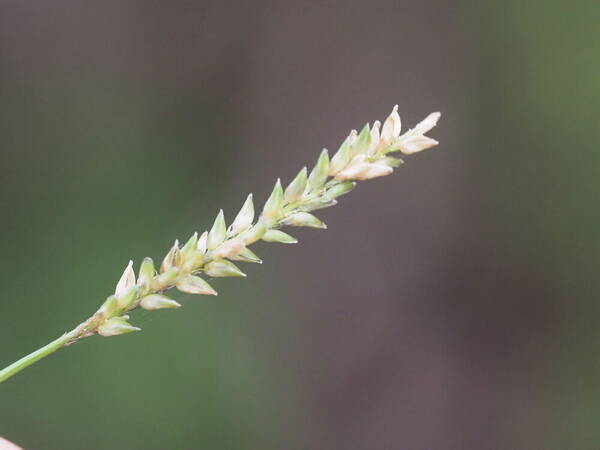Info
Subfamily: Panicoideae
Genus etymology: Sacciolepis = "bag scale" [Greek] refering to the gibbous fertile floret
Species etymology: indica = from india
Photosynthetic type: C3 (cool season)
Nativity: naturalized - accidental
First recorded in Hawaiʻi: 1908
Map


Inflorescence










Plant


Habit

Spikelets


Description
Decumbent or ascending annual; culms 10–100 cm. high, slender, often with aerial roots from the lower nodes. Leaf-blades broadly linear, 2–20 cm. long, 1–7 mm. wide, neither papillose nor ribbed, with or without sheath auricles up to 2 mm. long. Panicle cylindrical to oblong, 1–13 cm. long. Spikelets narrowly ovate, laterally compressed, 2–3 mm. long, glabrous or pubescent; lower glume ovate, 1/3–2/3 as long as the spikelet; upper glume membranous; lower floret ♂ or barren, its palea 0.5–1.8 mm. long, much shorter than the lemma; upper lemma 1/2–2/3 as long as the spikelet, white.
(Description source: Clayton, W.D. & Renvoize, S.A. 1982. Flora of Tropical East Africa. Gramineae (Part 3). A.A. Balkema, Rotterdam. 448 pp. )
Decumbent or ascending annual. Culms 10–100 cm. high, often with aerial roots from the lower nodes. Leaf laminae broadly linear, not papillose nor the nerves raised, with or without sheath auricles up to 2 mm. long. Panicle 1–13 cm. long, cylindrical to oblong. Spikelets 1.5–3 mm. long, narrowly ovate, glabrous or pubescent.
(Description source: Launert, E. & Pope, G.V. (eds.). 1989. Flora Zambesiaca. Volume 10. Part 3. Kew, London. 152 pp. )
Plants annual; cespitose. Culms 5-100 cm, decumbent, spreading, trailing, often rooting at the lower nodes; nodes glabrous. Sheaths and collars glabrous; ligules 0.1-0.7 mm long, membranous, truncate; blades 1-14.3 cm long, 1.5-5.5 mm wide, glabrous, not cordate at the base. Panicles 0.5-9(13) cm long, 4-7 mm wide, contracted; primary branches fused to the rachises for at least 3/4 of their length; lower branches 0.1-0.5 cm; pedicels 0.3-1.8 mm. Spikelets 2.1-3.3 mm, with or without papillose-based hairs on the upper glumes and lower lemmas, green to dark purple. Lower glumes 1.1-1.9 mm, glabrous, 3-5(7)-veined, margins hyaline; upper glumes 2-3.3 mm, slightly saccate, glabrous adaxially, 9-veined; lower florets sterile (rarely staminate); lower lemmas 1.9-3.1 mm, 7-9-veined, veins equidistant; lower paleas 0.5-1 mm long, 0.1-0.2 mm wide, 1/2 or less as long as the lower lemmas, narrow, membranous, white, not veined; upper lemmas 1.3-1.6 mm, subcoriaceous, glabrous, shiny, white, with 3-5 obscure veins, acute; anthers 3, 0.5-0.8 mm, dark reddish-brown to reddish-purple; styles purple. Caryopses 1-1.3 mm long, 0.5-0.7 mm wide, glabrous. 2n = 18, 36.
(Description source: Barkworth, M.E., Capels, K.M., Long, S. & Piep, M.B. (eds.) 2003. Flora of North America, north of Mexico. Volume 25. Magnoliophyta: Commelinidae (in part): Poaceae, Part 2. Oxford University Press, New York. 783 pp http://floranorthamerica.org/Sacciolepis_indica )
Annuals or perennials, + weakly rhizomatous; culms tufted, decumbent, branching from base, 15-50 cm long, slender, glabrous. Leaves usually near base of culm; sheaths glabrous, shorter than internodes; ligule membranous, 0.1-0.3 mm long; blades 3-10 cm long, 2-4 mm wide, glabrous. Inflorescences 1.5-7 cm long, usually less than 5 mm in diameter, often tinged purple, peduncle slender, 10-23 cm long, often constituting more than 1/2 the height of the plant; spikelets pedicellate, strongly imbricate and concealing the rachis; first glume ovate, boat-shaped, 1.1- 1.5 mm long, 5-nerved, second glume boatshaped, 2.5-2.8 mm long, 7-nerved, apex blunt; first floret sterile, biconvex, 2.5-2.8 mm long, glumes striate, first lemma similar to glumes, saccate at base, 7-9-nerved, concealing a narrow, stiff palea ca. 1 mm long; second floret fertile, second lemma chartaceous, narrowly ovate, ca. 1.5 mm long, smooth, lustrous, nerves obscure, apex acute; palea nearly as long as lemma. Caryopsis brown, ovoid, slightly compressed, ca. 1 mm long. [2n = 18. 36.]
(Description source: O’Connor, P.J. 1990. Poaceae, pp. 1481–1604. In: Wagner W.L., Herbst D.R. & Sohmer S.H. (eds.)., Manual of the flowering plant of Hawaiʻi. Vol. 2. University of Hawaii Press & Bishop Museum Press, Honolulu )